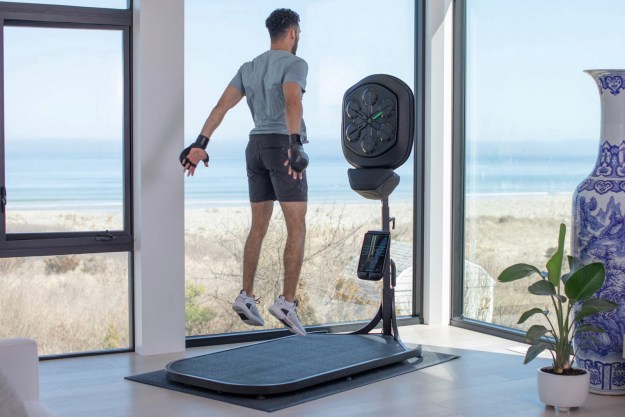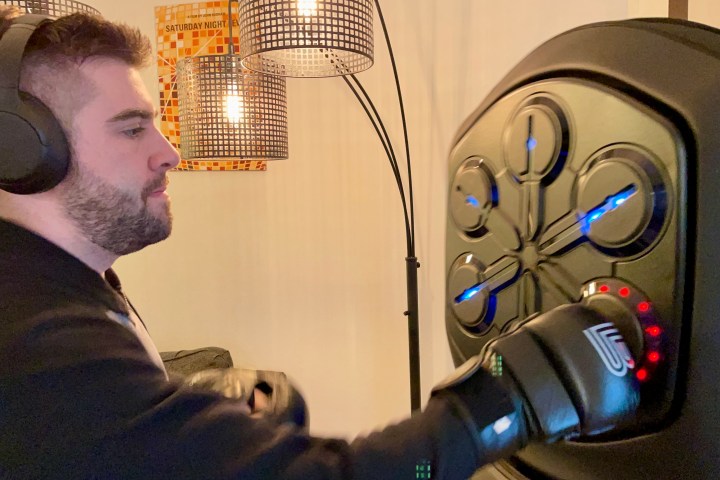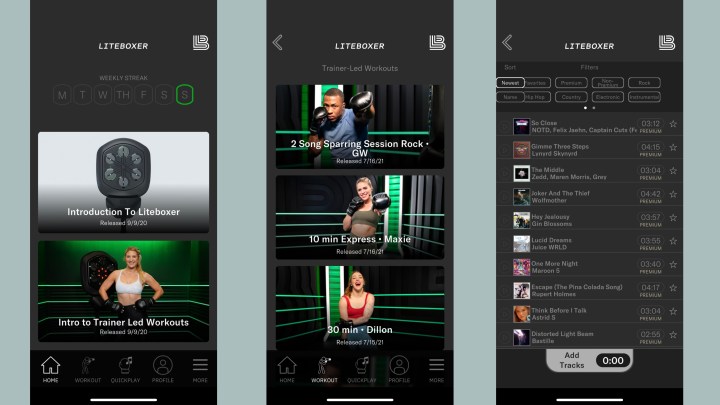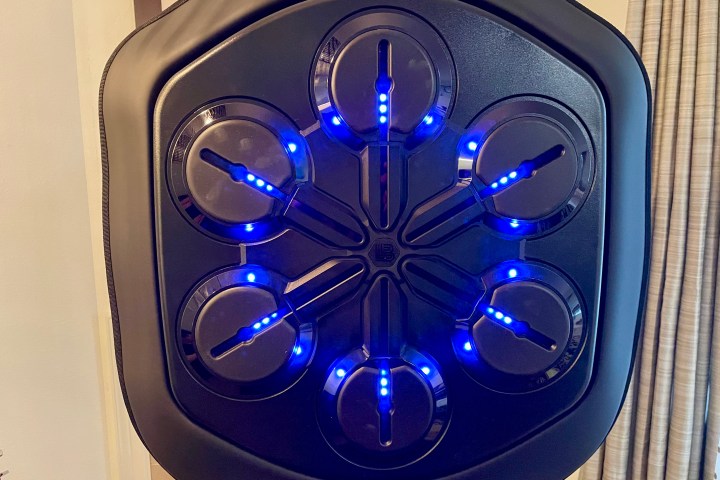
“Its design may present challenges for some, but the Liteboxer offers an immersive workout at home.”
- Bulletproof design
- Intuitive app
- Excellent trainer courses
- Invigorating workout
- On the pricey side
- No speakers
Over the last few years, the typical gym-based workout has been transitioning into fitness regimes we create and follow in our own homes. Companies like Peloton have long provided an at-home outlet for extensive cardio training but dedicated muscle-group equipment is a bit of a harder find and tougher sell.
While we’ve tried our hand at several home gym packages that have made the grade or missed the target in one way or another, the one question we never thought to ask is how exactly would we stack up in the boxing ring? Technically, we didn’t have to ask. Liteboxer did that for us.
Launched in 2020, Liteboxer is an at-home boxing workout machine that combines music, LED light pulses, and instructional content to deliver a rapid-fire experience that’ll have you jabbing and crossing your way to a high score. Is it a major upgrade over a cellar-dwelling punching bag? Let us be the judge.
Built to mean business, especially size-wise
At-home fitness gear tends to shoot for somewhat of a compact design, even if the final product is relatively close to the stature of something you’d find at your local gym. Going all-in on the concept of an at-home boxing experience, the Liteboxer calls for big space. Fully assembled, you’re looking at a footprint of 37.5 inches by 55.5 inches.
My demo unit was assembled in the living room of my apartment, and while not totally cumbersome, the machine was tough to live around at times. Ideally, you’ll want to ensure you have a dedicated rec space to use the Liteboxer. At-home gyms, garages, and open basements would be my suggestion.
By the end of each Liteboxer round, my party guests were sore, sweaty, and short of breath.
In terms of the actual hardware, you can expect delivery of your $1,695 Liteboxer kit in two separate boxes. Assembly is required unless you opt to go with the company’s white-glove install. The pieces include the main punching shield, a height-adjustable pedestal with a tablet mount, and the platform you stand on (two pieces). If you want a little more workout real estate, you can purchase a third platform section, netting you an extra 20 inches of boxing area. You’ll also receive boxing gloves, hand wraps, hex wrenches, and general assembly hardware.
Rhythm gaming meets boxing fundamentals
The Liteboxer’s Smart Shield is your heavy-duty opponent, complete with six individual target zones with force sensors. As you box, runway lights emit from the center of the shield and head towards one of the six hit zones. Your goal is to punch the target as soon as the runway LED hits the center. Direct hits light up green, while bad lands flash red.

I had some initial doubts about how much of a beating a glorified punch-pad could take, but I was proven wrong immediately. I hosted a family gathering and invited everyone to pound on the Liteboxer. Man, it can take a beating. Even the hardest slams from those more muscularly inclined than myself (everyone at the party) left the Smart Shield in place and the Liteboxer platform firmly rooted.
As you pummel through a round, your boxing stats are tracked in the Liteboxer app (available for iOS and Android devices). The app tracks the overall score for a single round, as well as hit accuracy and force (sensitivity can be adjusted in the app). Elements like this push the Liteboxer into more of a gaming domain, as opposed to the full-bodied boxing apparatus it’s marketed as. I’m not saying this is a bad thing at all. Working out can be a slog, but “gamifying” fitness is an inspiring and engaging way to get more people involved in some form of physical activity — and Liteboxer will definitely get your heart pumping.
By the end of each Liteboxer round, my party guests were sore, sweaty, and short of breath. Thus, our homemade sangria was much appreciated (there was water, too).
Jab with a trainer, spar to music, or reign freestyle blows
Similar to Peloton bikes and other leading fitness hardware, there’s an intuitive app that runs the show for the Liteboxer. And, like its competition, there are a number of features locked behind a monthly membership pay-gate. After your first three months of free premium features, the classes and a majority of the music catalog demand a price point of $29/month. Subscriptions are rather par for the course these days when it comes to innovative at-home workouts, but you get a lot with your Liteboxer membership.

For starters, there’s an impressive lineup of training courses with real-time instruction. Trainers build their courses around multiple songs with classes divvied up by music genre, length, and workout style. Under the Build + Restore tab, you’ll find instructional videos for everything from 20-minute total body conditioning workouts to targeted muscle-group training.
Stepping away from instructors, there’s a tab called Quickplay in the app. Here you’ll find three categories: Punch Tracks, Freestyle, and Thumboxer, the latter being more of a “bonus” mobile mini-game that replicates the Liteboxer experience on your phone screen. Punch Tracks is where you’ll find Liteboxer’s entire library of streamable songs that you can filter by genre and premium or non-premium tiers. While there’s a decent selection of non-membership tracks, you’ll want to pay the $29 monthly fee to unlock the rest of the archive.
The idea behind Freestyle mode is for you to box along to the beats of your own music. Once the app is linked to your Liteboxer, start up a track and start working on your punches, combos, and overall endurance.
Impressive bones, but lacking some tech
Stepping foot onto the Liteboxer platform, one thing you won’t see is an interactive touchscreen of any kind. While the company is more than transparent about the fact that you’ll require a mobile phone or tablet to properly use the Liteboxer, that doesn’t mean that some kind of built-in display isn’t missed. I always appreciate being able to ditch my devices in favor of my Peloton’s display. It gives me a break from thumbing away on my phone, keeps my device from being caked in sweat or damaged, and relegates all of the necessary features and settings into a sleek and easy-to-reach interface.
I also wasn’t too crazy about the Liteboxer’s actual tablet mount. Yes, the machine is built for more of an audio-driven workout experience, but the trainer-led courses are video lessons that you’re going to want to look at during some point in your class. The only way to observe is to dip your head and neck to take in your tablet, making it difficult to properly aim and land your hits on the punch-pad.
I wouldn’t exactly say these are deal-breaking deterrents for me, but they could be for some. For the $1,695 price point, it would certainly be nice to at least have speakers on the Liteboxer. Sure, headphones are a go-to fitness tool that most use, but plugging my ears up during a workout gets irritating after a while, and not everyone owns an external Bluetooth speaker (or one that is loud enough to be heard over the sound of your fists hitting the punch-pad).
Our take
If you ask me, I think it’s tough to get at-home fitness gear nailed down. If a company goes too hard with entertainment tech, the hardware can become more of a towering game system than something built to tone our bodies. Then again, you kind of need that element of fun to draw in those that may not be so willing to jump on a stationary bike or weight trainer.
I actually think that Liteboxer does a decent job of landing comfortably in the middle. It’s a blast to use and it feels like you’re getting a good workout. Is it a fully realized boxing simulator? I’m no pro but my guess is not quite, especially considering how little you’re actually moving when you’re on the platform and the fact that your opponent is stationary, too.
Is there a better alternative?
Yes, but it mainly hinges on what kind of workout you want. Obviously, Liteboxer specializes in boxing, but another boxing alternative is FightCamp. It’s a bit more traditional with its upright punching bag and also throws in some kickboxing workouts.
For more general workouts, you have connected fitness mirrors like Mirror and Tempo, which both also offer their own spin on boxing workouts with the help of instructors. Plus, there’s a bit more tech involved with them as they employ heart rate sensors, fancy displays that help guide you, and built-in speakers for plenty of music to go along with your workouts.
How long will it last?
The Liteboxer is built like a tank, and proper cleaning will help reduce the wear and tear over time. In the event of a defect, there’s a one-year limited warranty that’s included with the purchase.
Should you buy it?
If you’ve got the $1,000+ to spend (along with the $29/month membership cost) and want a cool centerpiece for your basement gym and a party pleaser, the Liteboxer might be a good fit for you and yours. Now, throw in some onboard speakers, a screen, a few design tweaks, and keep the price the same, and I think we’d see just as many Liteboxer setups around as we do Pelotons. Here’s hoping for a Liteboxer 2.0.
Editors' Recommendations
- HelloFresh free trial: Can you get your first box for free?
- How often should you replace your robot vacuum?
- The new Ring Intercom lets you buzz folks into your building from afar
- 6 settings you should disable on your Echo right now
- 7 ways to prep your smart home before you go on vacation








